这两天用到了Tree控件,发现在往树上绑定数据的时候不是特别方便,便写了一个辅助类。 在开始之前先说明一下如何使Tree控件支持有层次结构的数据源绑定,首先需要在xaml代码里为树增加HierarchicalDataTemplate模板,这样Tree就支持分层结构的数据源绑定了。
xaml代码如下:(注明:这里我还用到了一个Toolkit里的DragDrop控件,可以先忽略)
<!--Tree--> <controlsToolkit:TreeViewDragDropTarget AllowDrop="true" HorizontalContentAlignment="Stretch" VerticalContentAlignment="Stretch"> <controlsToolkit:TreeViewDragDropTarget.Resources> <common:HierarchicalDataTemplate x:Key="hierarchicalTemplate" ItemsSource="{Binding Children}"> <StackPanel Orientation="Horizontal"> <ContentPresenter Width="16" Height="16" Margin="0 0 4 0" Content="{Binding Icon}" /> <TextBlock Text="{Binding Name}"/> </StackPanel> </common:HierarchicalDataTemplate> </controlsToolkit:TreeViewDragDropTarget.Resources> <controls:TreeView x:Name="tree1" ItemTemplate="{StaticResource hierarchicalTemplate}" AllowDrop="True"/> </controlsToolkit:TreeViewDragDropTarget>
辅助类的代码:
/// <summary> /// Tree<T> /// </summary> public class Tree<T> where T: new() { /// <summary> /// 构造 /// </summary> public Tree(string nodeName, string iconName = null) { this.Value = default(T); this.Children = new ObservableCollection<Tree<T>>(); // 图标及名称 this.Name = nodeName != null ? nodeName.Trim() : string.Empty; this.IconName = iconName != null ? iconName.Trim() : string.Empty; } /// <summary> /// 构造空节点 /// </summary> public static Tree<T> Empty { get { return new Tree<T>(String.Empty); } } /// <summary> /// 构造实体 /// </summary> public ObservableCollection<Tree<T>> Entity { get { ObservableCollection<Tree<T>> entity = new ObservableCollection<Tree<T>>(); entity.Add(this); return entity; } } /// <summary> /// 子节点集合 /// </summary> public ObservableCollection<Tree<T>> Children { get; set; } /// <summary> /// 节点值 /// </summary> public T Value { get; set; } /// <summary> /// 图标名 /// </summary> public string IconName { get; private set; } /// <summary> /// 名称 /// </summary> public string Name { get; private set; } /// <summary> /// 图标 /// </summary> public Image Icon { get { return ImageFactory.GetImage(this.IconName); // 加载图片的函数,这个自己根据需要实现吧。 } } }
调用示例:
创建一个SampleDataClass类,用做附加在树结点上的数据类型,替换成自己的具体类型就可以了,这里只是一个例子。
public class SampleDataClass { public object Property1 { get; set; } public string Property2 { get; set; } }
Tree<SampleDataClass> root = new Tree<SampleDataClass>("Root", "Root.png"); Tree<SampleDataClass> node1 = new Tree<SampleDataClass>("node1", "Folder.png"); Tree<SampleDataClass> node2 = new Tree<SampleDataClass>("node2", "Folder.png"); Tree<SampleDataClass> node3 = new Tree<SampleDataClass>("node3", "Folder.png"); Tree<SampleDataClass> node4 = new Tree<SampleDataClass>("node4", "Folder.png"); Tree<SampleDataClass> node5 = new Tree<SampleDataClass>("node5", "Folder.png"); // 设定关系 node1.Children.Add(node2); node1.Children.Add(node3); root.Children.Add(node1); root.Children.Add(node4); root.Children.Add(node5); // 绑定 this.tree1.ItemsSource = root.Entity;
运行结果,如图:
已经可以用Tree<T>来管理你的数据结构了并且可以动态组织结构,同时可以使用Tree<T>.Value接口获取你在树结点上的附加数据。呃!上面那段示例的代码看上去很复杂?呵呵,其实那是因为我们是一行行自己组织的树结构,用程序实现那些树的结构和节点关系的话就优雅多了。再帖段实际应用时代码的样子:
// 创建目录索引 IDictionary<Guid, Tree<AH_Catalog>> treedict = new Dictionary<Guid, Tree<AH_Catalog>>(); foreach (AH_Catalog catalog in catalogService.AH_Catalogs) { treedict[catalog.CatalogId] = new Tree<AH_Catalog>(catalog.Name, catalog.Icon) { Value = catalog }; } // 建立目录关系 foreach (AH_CatalogInfo info in catalogService.AH_CatalogInfos) { treedict[info.Catalog].Children.Add(treedict[info.Children]); } // 加载根目录项 foreach (Tree<AH_Catalog> node in treedict.Values.Where(w => w.Value.Depth == 0)) { treeRoot.Children.Add(node); }
// 数据绑定 this.tree1.ItemsSource = treeRoot.Entity;
运行结果:
第二帖END!




